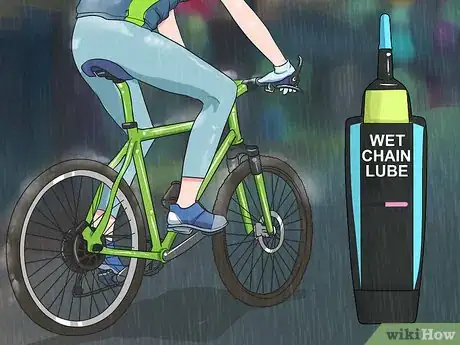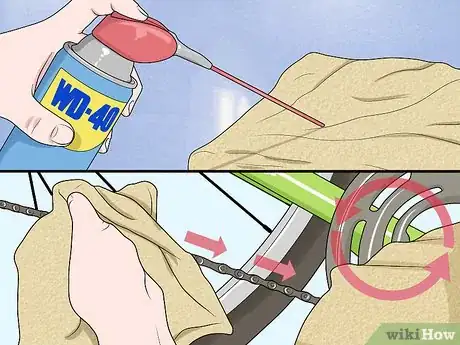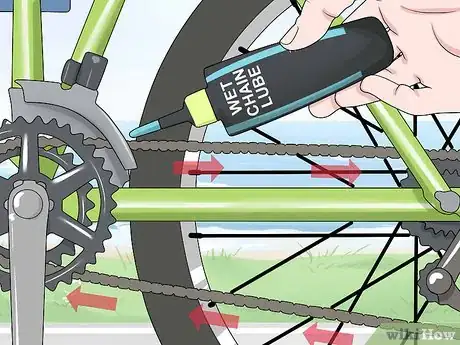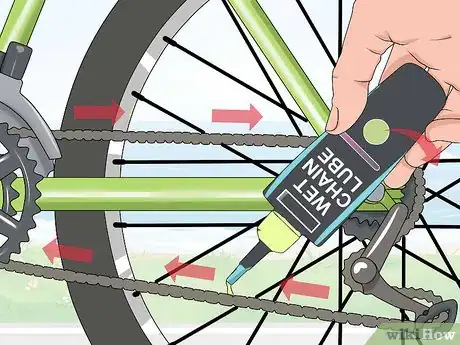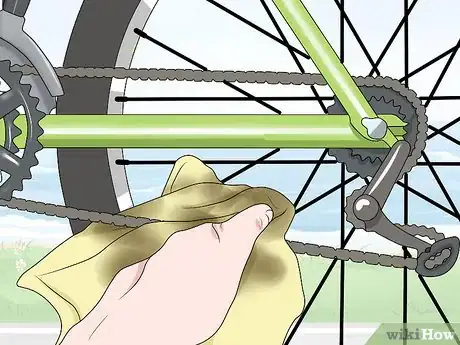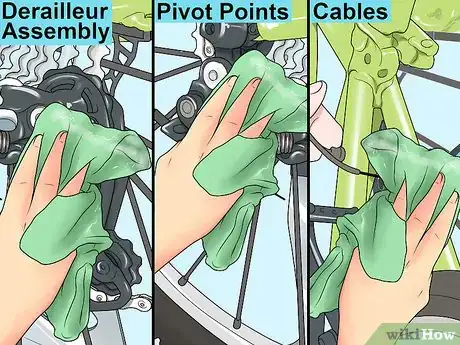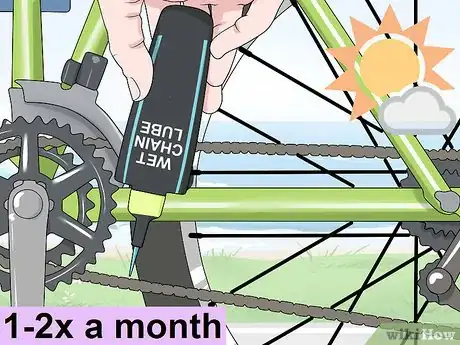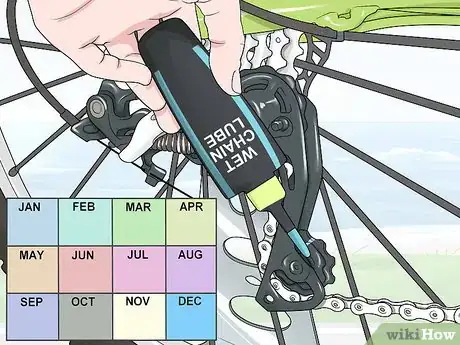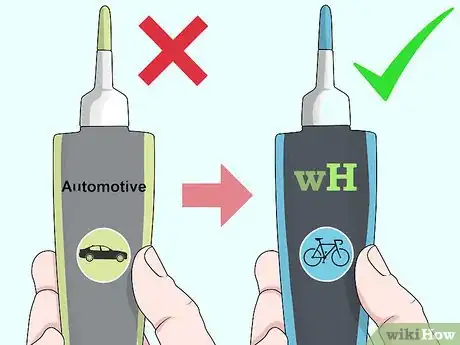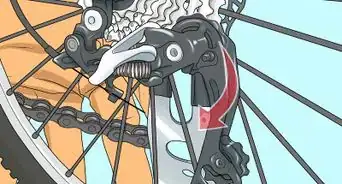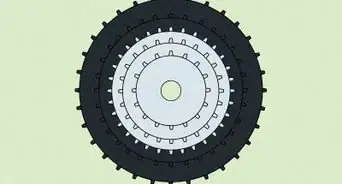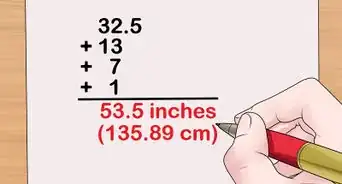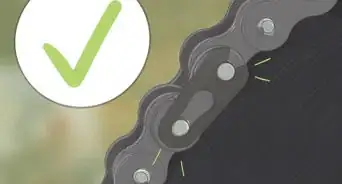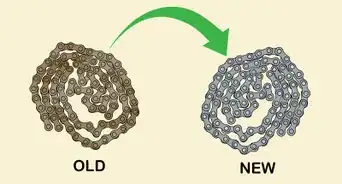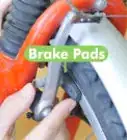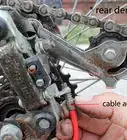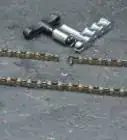This article was co-authored by Ikaika Cox. Ikaika Cox is the Shop Director at the Salt Lake City branch Bicycle Collective in Salt Lake City, Utah. He has been a bike mechanic since 2012, beginning as a volunteer with the Provo Bicycle Collective, and growing and honing his skills as a bicycle mechanic and educator in multiple Bicycle Collective locations over the years. He now leads the Salt Lake City branch of the Bicycle Collective.
There are 12 references cited in this article, which can be found at the bottom of the page.
This article has been viewed 24,614 times.
Lubricating a bike can be a bit messy, but it’ll help keep your ride safe and smooth. The chain will need attention more frequently than other parts, so lube it at least once a month. Clean it with a degreaser, dry it thoroughly, then apply a liquid bicycle lubricant with a straw nozzle. Lubricate other moving parts, including the derailleur and brake assemblies, at least every 2-3 months. To prevent grimy buildup that can compromise your bike’s performance, always wipe away excess lubricant with a clean, dry rag.
Steps
Lubricating the Chain
-
1Choose a wet lube if you ride in the rain. If you live in a rainy environment or frequently ride on wet, muddy trails, go for a wet chain lube. It's thicker, so heavy downpours and mud won't wash it away. If you live in a drier climate, choose a thinner chain lube marked for dry conditions.[1]
- You can find wet and dry bicycle lubricants online or at a bike shop. Make sure to use only lubricants marked for bicycles.
- If you frequently use your bike in both wet and dry conditions, buy one of each lube.
-
2Clean and dry the chain before lubricating it. It’s best to thoroughly clean your bike’s chain before you lubricate it.[2] Spray a clean rag with a bicycle degreaser or 91% isopropyl alcohol. With the bike in a work stand or propped up, grasp the chain with the soaked rag and use your hand to pedal the chain through the rag.[3]
- Pedal the chain through the rag until each of the chain’s links have passed through the cleaning rag two or three times. Repeat the technique with another clean rag to wipe away excess residue and dry the chain.
Advertisement -
3Lube the top of the chain. Touch the lubricant container’s straw nozzle to one side (either the inside of the chain closest to the frame or the outside) of the top of the bike chain. Spin the pedals forward to move each of the chain’s links past the lubricating nozzle. Once you’ve spun the chain in 2 complete rotations, repeat the process on the other side of the chain’s top.[4]
- Try not to apply too much lube as you pedal the chain. A little goes a long way, so just apply a thin stream. Wiping away excess will help make sure you cover the nooks and crannies.
-
4Lube the bottom of the chain if necessary. If you don't want to use too much lubricant, you don't have to lube the bottom of the chain. The drivetrain should move the lubricant around so it reaches the bottom of the chain.[5]
-
5Wipe away excess lubricant. You’ll need to get rid of excess lubricant after you’ve lubed the inner and outer edges of the chain’s top and bottom. Grasp the chain with a clean, dry rag and pedal forward to move the chain through the rag. Continue for 2 or 3 rotations, or until you’ve wiped away all the excess surface lube.[6]
- Wiping away the excess surface lube will help reduce dirt and debris from caking up your chain.
Lubing the Derailleur and Brake Assemblies
-
1Clean and dry the derailleur assemblies. The front and rear derailleur assemblies are sets of pulleys and cables that move your chain between gears when you shift.[7] Soak a clean rag with degreaser and wipe away any grease and grime from the assemblies’ pulley wheels and cables. Use a second clean rag to thoroughly dry the assemblies before lubricating them.[8]
-
2Touch the pulley wheels with the straw then backpedal. Touch the lubricant container’s straw nozzle to the center of the derailleur pulley wheel. Pedal backward a few revolutions to spin and thinly lubricate the wheel. Repeat the sequence for each of your bike’s pulleys.[9]
- Remember to use a lube marked for bicycles. Go with a product marked for wet or dry weather, depending on your local conditions.[10]
-
3Lube the pivot points and levers. There are several points at which your derailleur assembly and brakes pivot, or move in and out of place as you shift gears or brake. Once you’ve located the derailleur assemblies and lubed the pulley wheels, apply the brakes and shift gears to find your pivot points. Use the straw nozzle to apply a drop of lubricant to each pivot point, lever, and any other metal-on-metal joint.[11]
- Be sure to avoid getting lube on your brake pads.
-
4Lube the brake and shift cables if necessary. Since they’re contained in a nylon-lined housing, brake and shift cables don’t usually require lubrication.[12] However, if yours bind, click the shifter into the highest gear without pedaling and use the brake quick release to create enough slack to loosen the housing and slide out the cables. You can then apply a few drops of lube to the cables, wipe off excess, then slide them back into the housing.[13]
- If your cables are made of stainless steel, you shouldn't need to lube them.
- If you do need to lube the cables, use a graphite lubricant.
-
5Wipe away as much excess lube as possible. After lubing your derailleur assembly, pivot points, and cables, be sure to wipe away all excess surface lubricant. Excess lube will attract dirt and abrasive particles, which could compromise your bike’s performance in the future.[14]
Creating a Maintenance Routine
-
1Lube your chain once a week during drier weather. The chain needs to be lubricated more often than your bike’s other parts. If you ride your bike daily, you should clean it once a week or as soon as you hear any squeaking. If you don't ride your bike as often, you can lube the chain every 2 weeks.[15]
-
2Lube your chain after cycling in the rain. After a long ride in the rain, it’s best to give your bike chain some attention. Clean and dry it thoroughly as soon as you get home. After drying it off, lubricate it, then wipe away excess lube.[16]
-
3Lubricate other components every few months. Aside from the chain, your bike’s other components will likely need cleaning and lubrication every few months. If you live in a wet climate or frequently ride in the rain, you should lube the derailleur assemblies and other moving parts more often.[17]
- Always inspect and lubricate your bike when you first hear squeaking or other indicators of abrasion.
-
4Switch lubricants if your bike gets covered with grime. If you notice your bike is grimy whenever you perform maintenance, you should look into switching lubes. Instead of an automotive lubricant or thick grease, make sure you’re using a lubricant marked for bicycles, which is thinner in consistency.[18]
- If you notice lots of grime, you might also need to wipe off excess lubricant more thoroughly.
References
- ↑ http://www.bicycling.com/maintenance/lube/cyclists-guide-chain-lube
- ↑ http://www.bicycling.com/maintenance/bicycle-maintenance/where-use-bike-lubricant
- ↑ https://www.youtube.com/watch?v=guzy0h7gB3I&feature=youtu.be&t=59
- ↑ https://www.youtube.com/watch?v=guzy0h7gB3I&feature=youtu.be&t=72
- ↑ https://www.youtube.com/watch?v=guzy0h7gB3I&feature=youtu.be&t=95
- ↑ https://www.youtube.com/watch?v=guzy0h7gB3I&feature=youtu.be&t=103
- ↑ https://www.thoughtco.com/where-to-lubricate-your-bike-365651
- ↑ http://www.bicycling.com/maintenance/bicycle-maintenance/where-use-bike-lubricant
- ↑ https://www.youtube.com/watch?v=guzy0h7gB3I&feature=youtu.be&t=118
- ↑ http://www.bicycling.com/maintenance/lube/cyclists-guide-chain-lube
- ↑ https://www.youtube.com/watch?v=guzy0h7gB3I&feature=youtu.be&t=126
- ↑ http://campusbikeshop.com/how-to/bicycle-lubrication-pg316.htm
- ↑ https://www.youtube.com/watch?v=guzy0h7gB3I&feature=youtu.be&t=148
- ↑ http://www.bicycling.com/maintenance/bicycle-maintenance/where-use-bike-lubricant
- ↑ http://www.londoncyclist.co.uk/bicycle-lubrication/
- ↑ http://www.londoncyclist.co.uk/bicycle-lubrication/
- ↑ http://www.bicycling.com/maintenance/bicycle-maintenance/where-use-bike-lubricant
- ↑ http://campusbikeshop.com/how-to/bicycle-lubrication-pg316.htm
